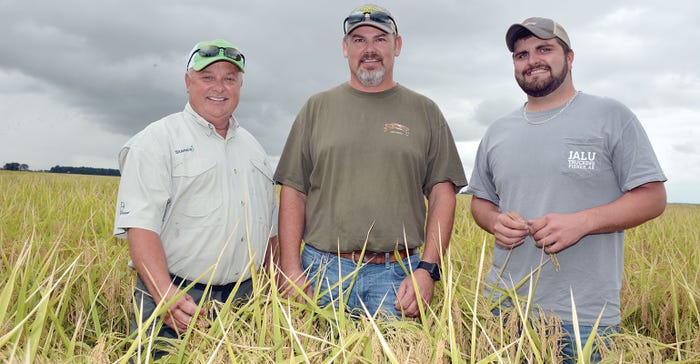
Jonathan Ashlock had to bide his time to take up his dream job — farming.
And Ashlock, 45, had to overcome some hard challenges to reach that goal. “During my first semester in college, my father died, and my mom couldn’t afford tuition, so I went to work,” he says on an overcast day in Poinsett County, Ark.
He scouted for crop consultant Eddie Cates, worked for nearby farmer Marty White and did what was necessary to stay in school. “When I graduated, it was all paid for. I didn’t owe anybody.”
He still had challenges. “No one in my family farmed,” he says. He had no land to take on, no equipment to borrow and no expertise to rely on to get him started.
He stayed as close to farming as he could get — scouting, working for an ag chemical company, and hiring on as a farm manager.
“I started taking on a few acres to farm,” he says, “and five years ago this farm came available and I had an opportunity to take on 4,000 acres. I got big in a hurry.”
It’s about as big as he wants. “I have what we are comfortable with,” he says. “We have to be able to do well on every field. More is not always better, and I want to manage what I have and get all I can from it. We have enough acreage to justify a ground spray rig. We have to have that. Our ag pilots do a good job, but we need the ground rig, too.”
His son, Logan Mitchusson, 22, farms with him. Together they manage a rice and soybean operation. Usually, half the acreage is in rice the other in beans. “I have about 2,400 acres of rice this year,” Ashlock says, “but I like the 50/50 rotation.”
Weed Issues
With a productive farm, a good rotation and five years of experience under his belt, the challenges don’t go away. Weeds, he says, offered the biggest one this year. “We got off to a rough start. It was dry, and we needed to flood the rice fields, but we have some saline and high pH water that is not good for young rice. If we put this nasty water on small rice it will kill it. So we got behind.”
He says in most cases the crop caught up. “A few spots look bad.”
He adds that his crop consultant, Cates, one of the men who helped him get started, worked with him to get the weeds under control. “I just did what Eddie recommended,” he says. “Eddie got it cleaned up.”
The rice crop looks promising, he adds, on a day when he would have been harvesting if the previous evening’s rain had not kept him out of the field.
“We’ve cut about 550 acres and other than a grassy plot or two, it’s cutting 200 bushels per acre. Even the grassy field is producing close to 190 bushels. The fields are clean, for the most part, just a few grassy spots. We do get lucky every once in a while.”

Crop consultant Eddie Cates, left, checks rice fields with Jonathon Ashlock and his son Logan.
Zinc Deficiency
Cates says the high pH water does more than set the rice back. “We have soils testing 7.5 and we have seen a lot of zinc deficiency the last two years.”
“When the rice comes up and we put on the first flood, that high pH water blows it up. I’ve been adding a foliar zinc when I let the water down. In 10 days to two weeks, we can see a difference,” Ashlock says. “Next year, when I pre-flood I’ll add foliar zinc.”
He says his water supply is excellent, wells as much as 390 feet deep. “We have a lot of wells from 250 to 260 feet, but we have good water, 1,300 to 1,500 gallons per minute.”
“It has been a challenge to keep up with water demand this year,” says Cates.
“We have some white clay soils,” Ashlock adds. “It packs and forms a hard pan. We can break it, run a chisel plow, and in a year or a year-and-a-half, it packs down again.”
He says they have been able to shut the pumps down for only a few days all season. “It’s particularly hard to get that first flood out. The fields are so big it takes a long time to get water from one end to the other.”
He likes 100-acre fields of rice, for one well, but that well may also cover about 100 acres of soybeans.
He likes the rotation, and says current acreage is “about all we have enough water to manage.”
The bean crop looks promising, too. “I plant soybeans early and look for 60 bushels per acre. The crop looks good.”
Cates says farmers have moved to earlier soybean planting and are seeing improved yields. “But we have some issues with herbicides.”
With early planting, aerial applicators are more selective about the herbicides they use on soybeans. Some can be hard on young rice. That’s another reason Ashlock likes having a ground rig.
“Also, sometimes pilots have to wait on wind direction to apply herbicides and they have customers waiting. The ground spray rig keeps herbicide applications timely.”
Almighty Pigweed
Cates say barnyard grass is a big issue, as are eclipta, and coffee bean. “We chase the almighty pigweed, too,” Ashlock says. “Around July 4, we start about 6:30 every morning, go into the fields and pull pigweed for an hour or an hour-and-a-half. We carry them out in garbage bags and dump them in a hole in the woods.
“I also keep a pump-up sprayer in my truck. When I see a pigweed, I get out and spray it. We rotate rice and beans and we still have pigweed,” Ashlock says. He would like to see dicamba made available for use on the Xtend soybeans. “We need it, but maybe with a realistic cutoff date.”
Cates says some herbicides, other than dicamba, may damage soybeans. “It’s a good idea to check varieties; some are more tolerant than others.”
Ashlock plants all Xtend soybean varieties, noting that they yield better than other options. Without dicamba availability, he might have to use another option, but he prefers to stay with Xtend for their yield potential.
He plants mostly hybrid rice varieties. “I moved to hybrids four or five years ago. They seem to be more sensitive to herbicide, salt and high pH,” he admits. “But they are also more forgiving. You can stump your toe in season and the hybrid varieties will still make.”
He particularly likes RiceTec 7311, a Clearfield variety. “I’ll plant all we can get next year,” he says. He would have planted more this year, but availability was an issue. It yields better than other varieties he’s grown, he says, “and stands better.”
Low Prices
Ashlock says he has good rice and soybean crops in the field, “if I can just hold them.” But he would like to see better prices. “We need to make good crops and get a decent price,” he says, “not $4.80 rice and $8 soybeans. We’ve lost $1.50 off soybeans since the tariffs went on.”
He says he has about as much acreage as he wants, but he is considering adding on-farm storage to take advantage of post-harvest price movement. “We get kicked in the teeth selling out of the field,” he says. “We always see a better price for rice in January.”
He can also control moisture better, harvest at 19 percent to 20 percent moisture and dry it down. Waiting can cause trouble. “If we hold off until they dry down to 14 percent and get a rain on them, the rice gets damaged and it’s dogfood.”
No Regrets
Ashlock says he has no regrets about pursuing his dream of farming on his own. “I’ve always wanted to farm. I enjoy doing it.”
He says good help makes the job, if not easier, at least more manageable. And he credits Cates and White for their support.
“I learned about scouting from Eddie and I learned to farm from Marty.”
About the Author(s)
You May Also Like






